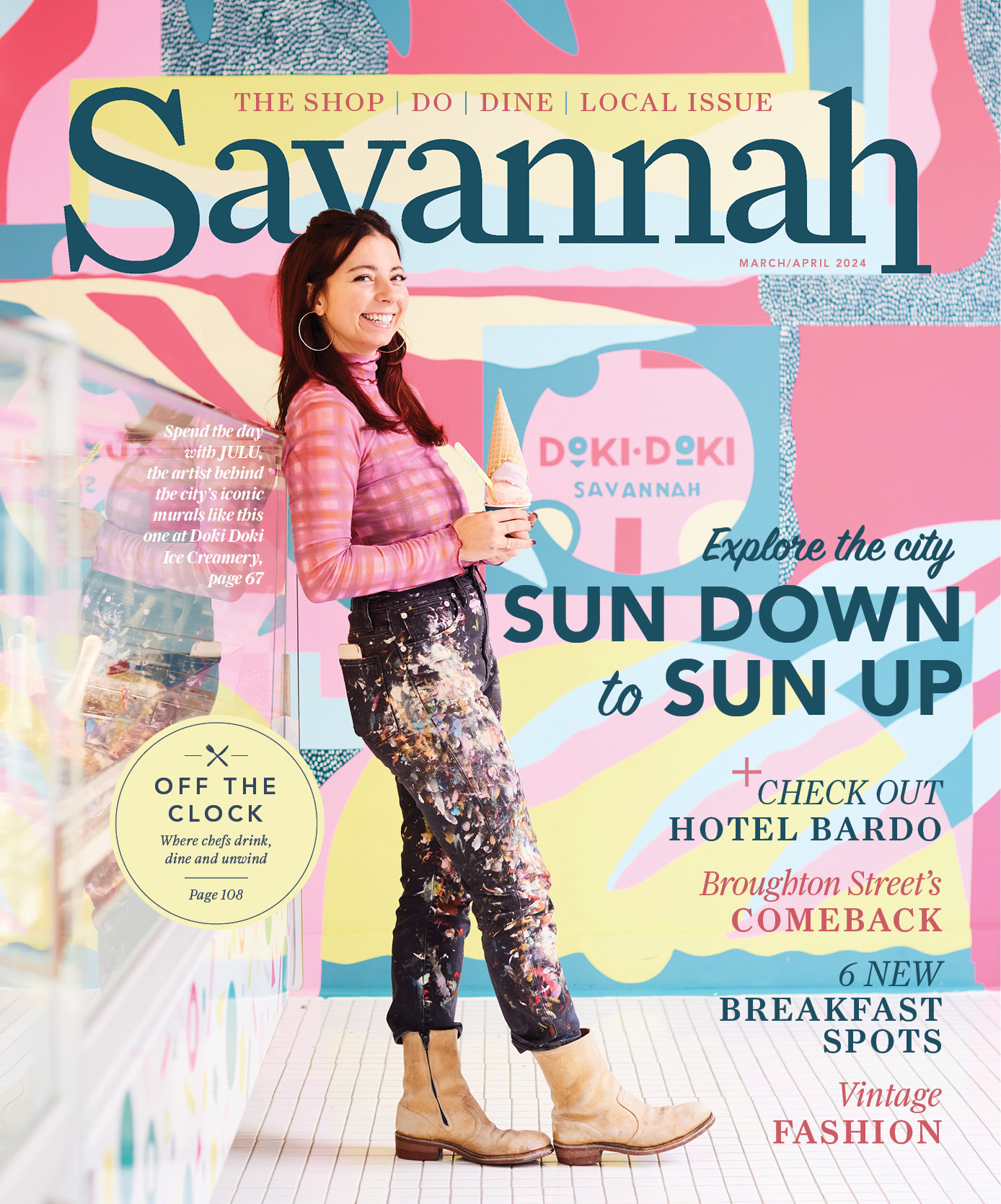Free from the constraints of Victorian formality, a fashion-forward couple makes an elegantly lighthearted retreat. Photography by Richard Leo Johnson.
A gilded pier glass leans against the wall behind a console table just inside the soaring entrance to Andy Shearer and Michael Fink’s Queen Anne duplex near Forsyth Park. A sepia-toned majolica urn sits beneath the table against a curved leg, holding half a dozen vintage wrestling action figures. Atop the table, three gnomes acquired by Michael during a buying trip to Paris stand sentinel beneath glass—the kind under which Victorians might have displayed a stuffed pheasant. One of the gnomes carries an axe; another wields a guitar.
“They took some getting used to,” Andy says with a note of seriousness. “I think they’re a little creepy. I don’t want them out in the open.” He smiles broadly, then erupts into laughter.
It’s this wink-and-nod toward refinement and kitsch—the juxtaposition of high and low that’s oh-so-Savannah—that gives Andy and Michael’s home its wit, whimsy and warmth.
Everywhere I turn, their joie de vivre is evident—in the bowls filled with family photos, the mess of silver mirrors on the dining-room mantel, the toys and the trophies. Their refreshing and amusing collections, gathered from New York flea markets, online auctions and trips abroad during their 25-year partnership, invite conversation and breathe fresh air into a stately place that had fallen on hard times before they rescued it three years ago.
Good Bones
Andy and Michael relocated from Manhattan to Savannah in 2009 when Michael, Saks Fifth Avenue’s women’s fashion director at the time, was recruited by the Savannah College of Art and Design to serve as the first dean of its new School of Fashion.
“I remember coming into the city at night—one of those rare foggy nights—right onto Gaston Street with the fog, the moss, the gas lamps,” Michael tells me. “I wondered, ‘Where am I?’ I fell in love immediately.”
The cosmopolitan couple lived downtown for a year, getting to know the district by walking and biking around, before they committed to buying a place. After living in an 850-square-foot apartment all those years in New York, Andy and Michael wanted something “of Savannah.” Together, the couple searched every block until they discovered a three-story Victorian just west of Forsyth Park.
“It was a big, sad house,” Andy recalls, describing how the home, which had sat empty for more than two years, was stripped of all the ornate period influences by previous owners. The side porch was glassed in. The hardwood floors were worn bare. Drop ceilings were installed. Every wall was faux finished to disguise peeling plaster. And the floors and staircase were littered with dead birds—“lots of them”—in various stages of decomposition.
But the house, as they say, had good bones. And, it was a canvas on which they could make their own authorial mark.
They turned to Stephen Clark, the Pennsylvania-based architectural designer who has known Michael since their younger days attending the New England Conservatory of Music. It was Stephen who first introduced Michael to Andy, and his personal friendship with the couple gave him unprecedented insight into their shared aesthetic.
“Our first goal was to bring the house back to its original proportions,” Stephen explains. The entire HVAC system also had to be replaced, which enabled the designer to remove homemade ductwork and those depressing drop ceilings, opening the rooms up to their full 15-foot height.
Stephen’s second goal was to remove oddly placed additions, such as an ill-considered bathroom in the dining room that jutted into the kitchen. Next, he redesigned the approach to the second-floor master suite by moving a closet and bathroom toward the interior, opening up the outside wall to natural light.
With no period details to maintain, Stephen ebonized the floors throughout the home and infused the rooms with bright, clean colors to serve as backdrops to Andy and Michael’s eclectic mix of antique and modern furnishings and their storied collections.
“They aren’t afraid to step outside of predictable,” Stephen says.
Collective Soul
“I’m absolutely giddy with all this space,” Michael gushes, but he and Andy resist the temptation to fill up every inch of the home’s 3,000-plus square feet. “You have to respect the space because it’s so beautifully laid out here.”
They kept the glassed-in porch, remaking it into a light-filled reading room adjacent to the foyer so they could enjoy the outdoors and street life without sharing it with the mosquitoes.
Left of the porch, a winding staircase emblazoned with a scarlet handrail connects the public spaces downstairs with the private spaces above. In the foyer beneath the stairs sits a chair handcrafted from raw wood nailed askew—a piece of sculpture created by SCAD alum Kyle Millsap that they purchased at an art auction. Vintage portraits, picked up on their wanderings, fill the walls here and in other rooms. Imagining the histories behind these unknown but intriguing faces has become a party game.
The front parlor is warmed by fawn tones and rich textures. A classic Baughman sofa Andy and Michael found on eBay anchors the room. Mid-century chairs still draped in their original upholstery were unearthed in Alex Raskin’s magical emporium of antiquities on Monterey Square. An intricate C. Barry drawing hangs on the far wall beside the arched picture window. Nearby, an easel displays a portrait of Andy’s father—an 18-year-old sailor at the time—painted by celebrated 20th century American artist Gertrude McKim Whiting.
Andy reaches behind the painting and unfolds a write-up in the Park Avenue Social Review from 1944 that documents Whiting’s portraiture of U.S. and Australian military personnel during World War II. Andy’s father was selected to represent the U.S. Navy.
“I love that my parents kept this,” he says.
It’s a treasure among treasures in this room, where the marble mantel holds a jeweler’s glass—a small bit of sculpture itself—alongside a congress of disembodied doll eyes peering out from their thin wire stands.
House Party
Across from the parlor, an amorphous, reclaimed wood table from Clipper Trading Co. invites guests to linger over dinner and games of Celebrity.
“That’s what Savannah has taught us—to invite people into our home,” Michael says. “In New York, you meet people out, at restaurants, at shows. No one entertains at home.”
Andy recalls his parents hosting dinners at their Long Island residence and muses that the first time he and Michael held a party in this house, it felt like “a real grown-up moment.”
“It dawned on me, ‘I’m a host,’” he says. “I’ve become my parents. I wasn’t planning this at all.”
The airy kitchen beyond is bright white with accents of seal gray on the cabinets. Original cast-iron Corinthian columns provide support and frame the space. One column is covered with photos and clippings—Andy’s bar mitzvah and prom photos, Michael’s birthday celebration in Las Vegas, a test shot of Jim and Tammy Faye Bakker taken for a magazine, a headline of Liza Minnelli having a meltdown—it’s their version of refrigerator art. Ornate cast-iron desk lamps have been refashioned as under-cabinet lighting.
A serene painting of a deer by SCAD alum JenMarie Zeleznak hangs above the brick fireplace in the breakfast nook, where a canvas paint cloth has been repurposed as a Union Jack rug beneath the round table.
Hints of Andy and Michael’s humor abound—in a wall of framed cartoons and in a collection of old cookbooks, some from ‘70s television stars and others with deadpan titles such as Some Icelandic Recipes and Elegant Elk and Delicious Deer.
There are rumors this kitchen is haunted. The first week Andy and Michael moved in, they were sitting on the porch and overheard one of the hearse tour drivers, who was stopped in front of their house, describing the head of a boy floating above the kitchen island.
Michael laughs. “We haven’t even heard a creak.”
Amusement House
The second floor serves as Andy and Michael’s private retreat, replete with a den, a to-die-for dressing room (we would expect nothing less from the dean of fashion), a spa-like bath and a plum-colored master bedroom.
The den is the only room in the house with a television, but the on-screen action must compete with a plethora of entertaining art and visual pops against pale gray walls.
A golden wood table sits inside the bay window with a jigsaw puzzle scattered mid-completion. This is where Michael decompresses while Andy reads, relaxed in one of the room’s two club chairs.
Behind Andy, a wall of shelves surrounding one of the home’s seven fireplaces holds a collection of vintage chia heads.
“Who knew?” Michael says about their first discovery in a Paris thrift store. “I had no idea that chia heads went back (to the 1940s).” From that moment, he was possessed and bought as many as he could find. A far cry from the pop-culture terra cotta forms sold today, these heads sport carnival colors and amused expressions that force even the most curmudgeonly guest to break a smile.
Scanning the room, the enchantments continue. A glass pedestal bowl next to the fireplace is filled with the entire Munster family—in puppet form. A series of educational puppets, used in the ’50s and ’60s to illustrate the careers of doctors, police officers and nurses, reach out for hugs from a high shelf.
Stacked around the room are books by and about some of the 20th and 21st centuries’ greatest artists: Coco Chanel, Alexander McQueen, Balmain.
“To me, in design—regardless of whether it’s furniture, clothing, architecture—we are adapting the vocabulary that has been around forever to this time, connecting those dots,” Michael tells me. “The key to Oscar de la Renta’s and Karl Lagerfeld’s relevance is that they remain youthful and curious.”
The fashion doyen could just as easily be describing his and Andy’s aesthetic.
“Our philosophy is to have fun. It’s just a house,” he advises. “We didn’t put pressure on ourselves to have the most perfect place.”
Andy agrees. “It’s playful, not precious. I want people to walk out of here and think, ‘That was interesting and that was fun.’ If somebody thought it was precious, I would wonder what we did wrong.”
The Fink/Shearer Stats >>
Owners: Michael Fink and Andrew Shearer
Year built: 1871
Year purchased: 2010
Square footage: 3,235
Accommodations: 3 bedrooms, 2.5 baths
Time to complete: 5-6 months
The Fink/Shearer Referrals »
Architectural/interior designer: Stephen Clark, Stephen Clark Design Group, New Hope, Penn.
Contractor: Sam Carroll, Carroll Construction
Tile/flooring: Mike Adams, M.T. Adams Tile & Stone
Paint/wallpaper: Vince Csatajszki
Windows/doors: Carroll Construction
Kitchen/bath design: Stephen Clark
Lighting design: Stephen Clark
Electrician: Braddy Electric
Carpenter: Carroll Construction
Plumber: Jake Patrick, Jake Patrick & Son Plumbing Inc.
HVAC: Climatech Air Inc.
Appliances: Livingoods








